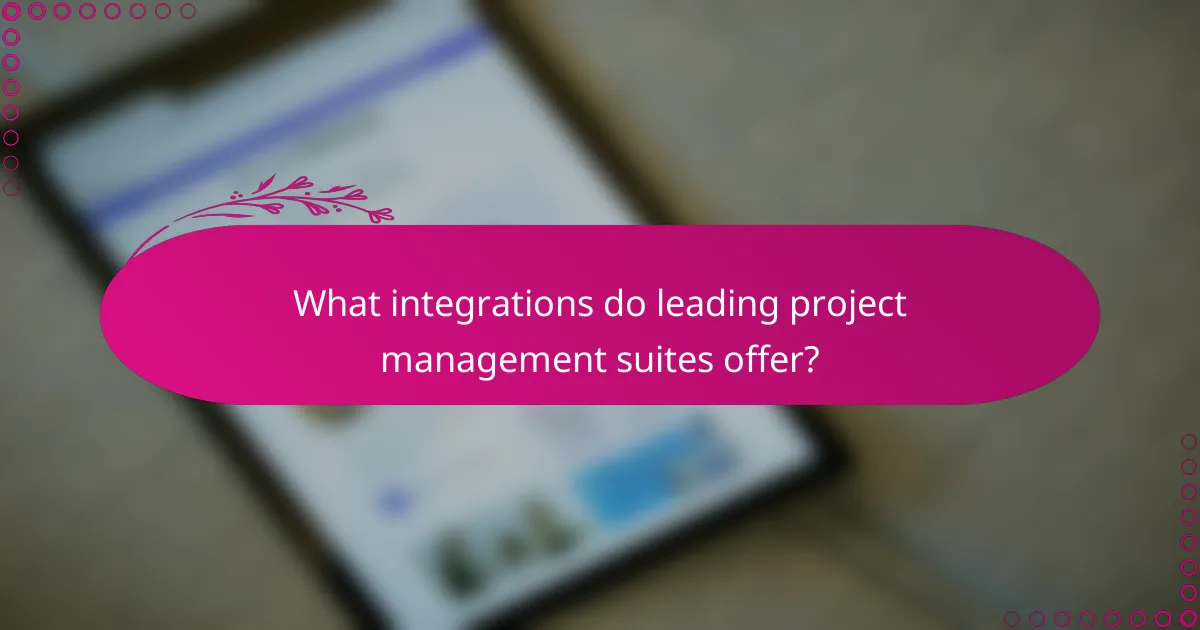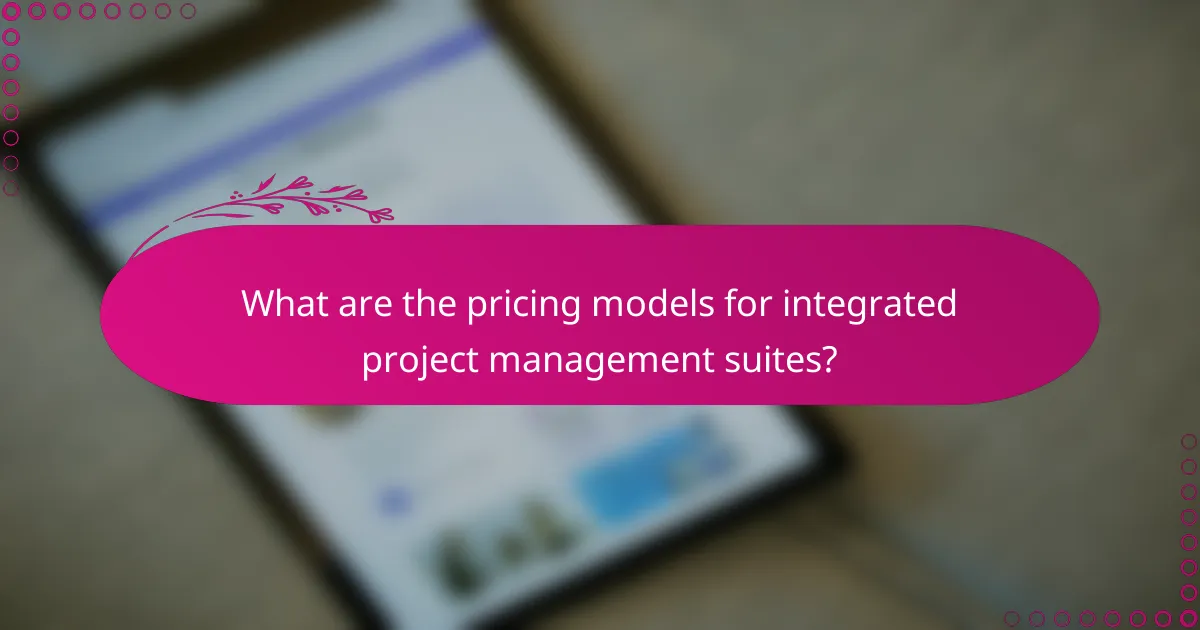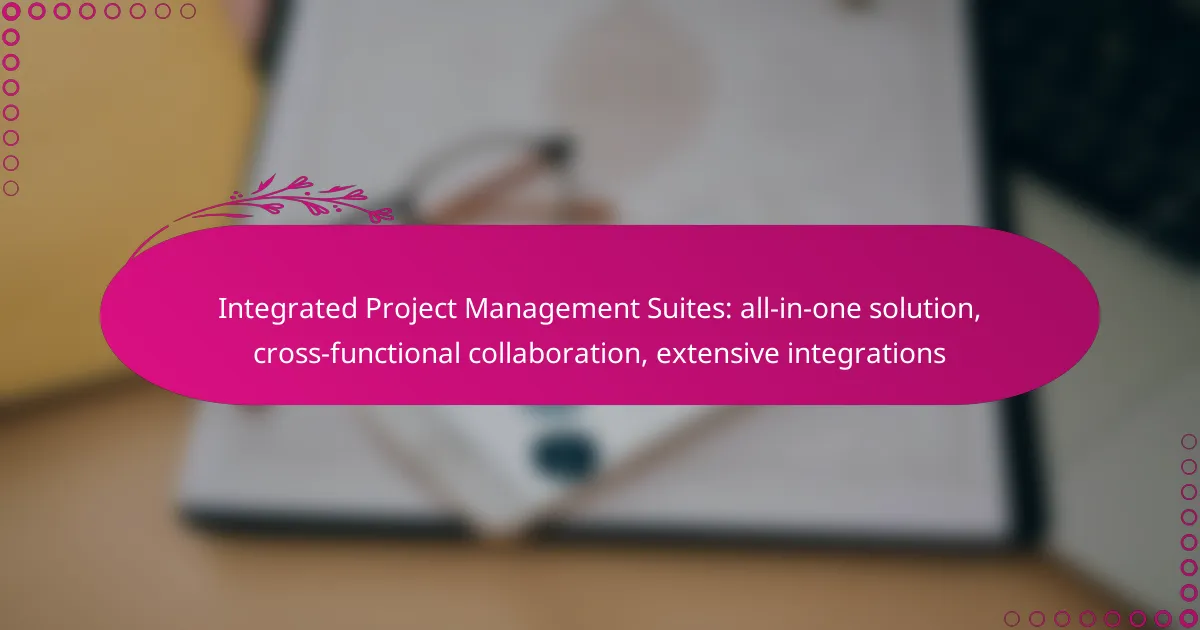Integrated project management suites serve as all-in-one solutions that combine planning, collaboration, and task tracking into a single platform. By enhancing cross-functional teamwork and offering extensive integrations, these tools streamline workflows and foster effective communication among diverse teams.

What are the best integrated project management suites in the UK?
The best integrated project management suites in the UK combine tools for planning, collaboration, and tracking tasks in one platform. These solutions enhance cross-functional teamwork and offer extensive integrations to streamline workflows.
Asana
Asana is a popular project management suite that focuses on task management and team collaboration. It allows users to create projects, assign tasks, and set deadlines, making it easy to track progress and ensure accountability.
Consider using Asana if your team values visual project tracking, as it offers various views like lists, boards, and timelines. Its integration capabilities with tools like Slack and Google Drive enhance productivity by centralizing communication and resources.
Trello
Trello utilizes a card-based system to manage projects, making it intuitive for teams to visualize their workflows. Users can create boards for different projects and move cards through various stages, which helps in tracking task completion.
This suite is particularly effective for smaller teams or projects due to its simplicity. However, its limited features compared to more robust platforms may require additional tools for comprehensive project management.
Monday.com
Monday.com offers a highly customizable platform that adapts to various project management styles. Users can create workflows tailored to their specific needs, incorporating features like time tracking, automation, and reporting.
This suite is ideal for teams that require flexibility and scalability. Its extensive integration options with software like Zoom and Microsoft Teams facilitate seamless collaboration across different tools.
Wrike
Wrike is designed for larger teams and complex projects, providing advanced features like Gantt charts and workload management. It allows for detailed project planning and resource allocation, making it suitable for organizations with multiple ongoing projects.
Consider Wrike if your team requires in-depth reporting and analytics capabilities. Its robust integration options with CRM and marketing tools can enhance project visibility and alignment with business goals.
ClickUp
ClickUp is an all-in-one project management suite that combines task management, document sharing, and goal tracking in one platform. Its versatility makes it suitable for teams of all sizes, allowing customization of workflows and views.
This suite is beneficial for teams looking for a comprehensive solution without needing multiple tools. Its integration with platforms like GitHub and Zoom can streamline processes and improve communication across departments.

How do integrated project management suites enhance cross-functional collaboration?
Integrated project management suites improve cross-functional collaboration by providing a unified platform for teams to communicate, share information, and track progress. These tools streamline workflows and reduce silos, enabling diverse teams to work together more effectively.
Centralized communication tools
Centralized communication tools within integrated project management suites allow teams to interact in real-time, reducing the need for lengthy email threads and fragmented discussions. Features like chat, video conferencing, and discussion boards help maintain clarity and keep everyone on the same page.
For example, tools such as Slack or Microsoft Teams can be integrated into project management suites, enabling instant messaging and file sharing directly related to specific projects. This ensures that all team members have access to the same information and can contribute to discussions as they happen.
Shared project visibility
Shared project visibility is crucial for cross-functional collaboration, as it allows all stakeholders to see the project’s status, timelines, and responsibilities. Integrated suites often include dashboards and reporting tools that provide a comprehensive view of project progress, helping teams align their efforts.
By using visual tools like Gantt charts or Kanban boards, teams can quickly identify bottlenecks and adjust their strategies accordingly. This transparency fosters accountability and encourages proactive problem-solving among team members.
Real-time updates
Real-time updates are a key feature of integrated project management suites, ensuring that all team members are informed of changes as they occur. This functionality minimizes delays and miscommunications that can arise from outdated information.
For instance, when a task is completed or a deadline is adjusted, notifications can be sent to relevant team members instantly. This immediacy helps maintain momentum and keeps everyone focused on their responsibilities, ultimately enhancing collaboration across departments.

What integrations do leading project management suites offer?
Leading project management suites typically offer a range of integrations that enhance collaboration and streamline workflows. Common integrations include tools for communication, document management, and video conferencing, allowing teams to work more efficiently across various platforms.
Integration with Slack
Integrating project management suites with Slack enables real-time communication and updates within teams. Users can receive notifications about project milestones, task assignments, and deadlines directly in their Slack channels, reducing the need to switch between applications.
To set up this integration, users usually need to connect their project management tool to Slack through an API key or an app marketplace. This setup allows for customizable notifications and the ability to create tasks directly from Slack messages.
Integration with Microsoft Teams
Microsoft Teams integration allows project management suites to embed project updates and task lists within the Teams environment. This integration facilitates seamless collaboration, as team members can discuss projects and access relevant documents without leaving the Teams interface.
To utilize this integration effectively, teams should ensure that their project management suite is linked to Microsoft Teams, enabling features like task assignment and progress tracking directly within chat channels.
Integration with Google Workspace
Integrating with Google Workspace enhances productivity by allowing users to link documents, spreadsheets, and calendars directly to their project management tools. This integration ensures that team members have easy access to the latest project files and schedules.
For optimal use, teams should connect their project management suite to Google Drive and Calendar, enabling automatic updates and reminders about project deadlines and meetings. This can streamline workflows significantly.
Integration with Zoom
Zoom integration provides a way for teams to schedule and conduct video meetings directly from their project management suite. This feature is particularly useful for remote teams, as it allows for quick communication and collaboration without needing to switch platforms.
To implement this integration, users typically need to authorize their project management tool to access their Zoom account. This setup can include features like adding Zoom links to project tasks or calendar events, ensuring that all team members can join meetings easily.

What are the pricing models for integrated project management suites?
Integrated project management suites typically offer various pricing models to accommodate different organizational needs and budgets. The most common models include subscription-based pricing, tiered pricing plans, and free trial options, each with its own advantages and considerations.
Subscription-based pricing
Subscription-based pricing is a prevalent model where users pay a recurring fee, usually monthly or annually, to access the software. This model allows organizations to manage costs effectively, as it often includes updates and support within the subscription fee.
When considering subscription plans, look for flexibility in user licenses and features. Many providers offer discounts for annual commitments, which can lead to significant savings over time.
Tiered pricing plans
Tiered pricing plans provide different levels of service at varying price points, allowing organizations to choose a plan that best fits their size and needs. Typically, these tiers range from basic features for small teams to advanced functionalities for larger enterprises.
Evaluate the features included in each tier carefully. Some plans may offer essential tools at a lower cost, while higher tiers might include advanced reporting, integrations, or enhanced support, which can be beneficial for larger projects.
Free trial options
Many integrated project management suites offer free trial options, allowing potential users to test the software before committing to a purchase. These trials typically last from a week to a month and provide access to most features.
Take advantage of free trials to assess usability and fit for your team. During this period, involve key stakeholders to gather feedback and ensure the suite meets your project management needs effectively.

What criteria should be considered when selecting a project management suite?
When selecting a project management suite, consider factors such as user-friendliness, integration capabilities, and support for cross-functional collaboration. These criteria ensure that the suite can effectively meet your team’s needs and enhance productivity.
Scalability
Scalability is crucial when choosing a project management suite, as it determines how well the software can grow with your organization. A scalable solution should accommodate an increasing number of users, projects, and data without compromising performance.
Look for suites that offer flexible pricing plans based on the number of users or features needed. For instance, some platforms may start with a basic plan for small teams and allow upgrades to more comprehensive packages as your organization expands. This flexibility can save costs while ensuring you have the necessary tools as your projects evolve.
Additionally, consider how well the suite integrates with other tools your team uses. A scalable project management suite should seamlessly connect with communication platforms, file-sharing services, and other software to facilitate collaboration across departments. This interconnectedness enhances efficiency and keeps everyone aligned on project goals.
